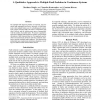Free Online Productivity Tools
i2Speak
i2Symbol
i2OCR
iTex2Img
iWeb2Print
iWeb2Shot
i2Type
iPdf2Split
iPdf2Merge
i2Bopomofo
i2Arabic
i2Style
i2Image
i2PDF
iLatex2Rtf
Sci2ools
AAAI
2007
2007
A Qualitative Approach to Multiple Fault Isolation in Continuous Systems
The multiple fault diagnosis problem is important, since the single fault assumption can lead to incorrect or failed diagnoses when multiple faults occur. It is challenging for continuous systems, because faults can mask or compensate each other’s effects, and the solution space grows exponentially with the number of possible faults. We present a qualitative approach to multiple fault isolation in dynamic systems based on analysis of fault transient behavior. Our approach uses the observed measurement deviations and their temporal orderings to generate multiple fault hypotheses. The approach has polynomial space requirements and prunes diagnoses, resulting in an efficient online fault isolation scheme.
| Added | 02 Oct 2010 |
| Updated | 02 Oct 2010 |
| Type | Conference |
| Year | 2007 |
| Where | AAAI |
| Authors | Matthew J. Daigle, Xenofon D. Koutsoukos, Gautam Biswas |
Comments (0)

